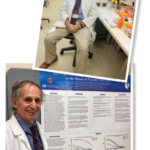ATLANTA—Encouraging data on interleukin (IL) 23/IL-17 pathway drugs in psoriatic arthritis (PsA), JAK inhibitors in rheumatoid arthritis (RA) treatment and new evidence on physical activity and bone health in women were among the highlights of the 2019 ACR/ARP Annual Meeting’s Clinical Year in Review.
Susan Manzi, MD, MPH, director of the Lupus Center for Excellence in the Autoimmunity Institute, Allegheny Health Network, Pittsburgh, who reviewed the clinical headlines, called it “the year for psoriatic arthritis.”
Early, aggressive tumor necrosis factor (TNF) therapy may be beneficial. A study of golimumab plus methotrexate (MTX) vs. MTX alone as first-line treatment of PsA found that not only was there a striking difference in DAS CRP remission over 22 weeks—81% for golimumab and 42% for the MTX-only arm—but the effects were seen early, with a significant difference after just eight weeks, Dr. Manzi noted.1

Dr. Manzi
Other results unveiled over the past year show that the IL-23 inhibitor risankizumab was superior to anti-TNF adalimumab for moderate to severe plaque psoriasis, with 72% vs. 47% respectively achieving at least a 90% reduction in the Psoriasis Area and Severity Index (PASI) over 16 weeks.2 Also encouraging was a large study showing no significant difference in atrial fibrillation and cardiovascular events between ustekinumab and TNF inhibitors.3
Dr. Manzi said data show JAK inhibitors “continue to show promise in RA,” including in patients refractory to biologic disease-modifying anti-rheumatic drugs.
Monotherapy with upadacitinib, a JAK-I inhibitor, in those with active RA and an inadequate response to methotrexate, produced significantly greater ACR20 responses than methotrexate alone over 14 weeks in a recent phase 3 trial.4
Other research has deepened clinicians’ understanding of how to prevent fractures in women. Data from the Women’s Health Initiative—with a population followed over 14 years—show that an increase in physical activity lowers the risk for total fractures and hip fractures among women. A key finding in the study, Dr. Manzi said, is that this protection was seen even in those who were sedentary for more than 9.5 hours a day.5
“Physical activity seemed to mitigate the risk of fractures seen with sedentary behavior,” she said. Mild physical activity, including golf and walking, lowered the fracture risk—an aspect of the study that “may change guidelines,” she said. “This is important since we can encourage light physical activity in our elderly patients who may be frail.”
In other corners of rheumatology, the U.S. Food and Drug Administration (FDA) approved the tyrosine kinase-inhibitor nintedanib for systemic sclerosis interstitial lung disease and the PDE4 inhibitor apremilast for oral ulcers associated with Behçet’s disease.


